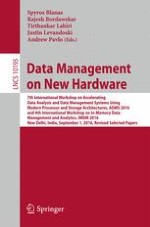This book contains selected papers from the 7th International Workshop on Accelerating Analytics and Data Management Systems Using Modern Processor and Storage Architectures, ADMS 2016, and the 4th International Workshop on In-Memory Data Management and Analytics, IMDM 2016, held in New Dehli, India, in September 2016. The joint Workshops were co-located with VLDB 2016. The 9 papers presented were carefully reviewed and selected from 18 submissions. They investigate opportunities in accelerating analytics/data management systems and workloads (including traditional OLTP, data warehousing/OLAP, ETL streaming/real-time, business analytics, and XML/RDF processing) running memory-only environments, using processors (e.g. commodity and specialized multi-core, GPUs and FPGAs, storage systems (e.g. storage-class memories like SSDs and phase-change memory), and hybrid programming models like CUDA, OpenCL, and Open ACC. The papers also explore the interplay between overall system design, core algorithms, query optimization strategies, programming approaches, performance modeling and evaluation, from the perspective of data management applications.
